To capture epic aerial wedding exit moments, you'll need careful planning and high-quality equipment. Choose a drone like the DJI Mavic 3 Pro for high-quality images and stable flight. Scout the venue beforehand to identify perfect angles and assess lighting conditions. Coordinate with the couple and ground photographers to choreograph the exit scene, ensuring everyone knows their roles. Master low-light techniques for night shots and be prepared for weather challenges. Don't forget legal requirements—obtain your FAA Remote Pilot Certificate and necessary permits. With the right approach, you'll soar above the crowd and create unforgettable memories. The sky's the limit for your wedding photography skills.
Key Takeaways
- Select open locations with minimal obstructions for optimal aerial patterns and visibility during the exit.
- Coordinate timing with the couple for the exit to coincide with golden hour for ideal lighting conditions.
- Choreograph the exit scene, positioning guests strategically and conducting a rehearsal to ensure smooth execution.
- Use high-quality drones like DJI Mavic 3 Pro or Autel EVO Lite+ for stable flight and superior image quality.
- Apply dynamic composition techniques, such as the rule of thirds and leading lines, to create visually striking aerial shots.
Planning the Perfect Aerial Exit
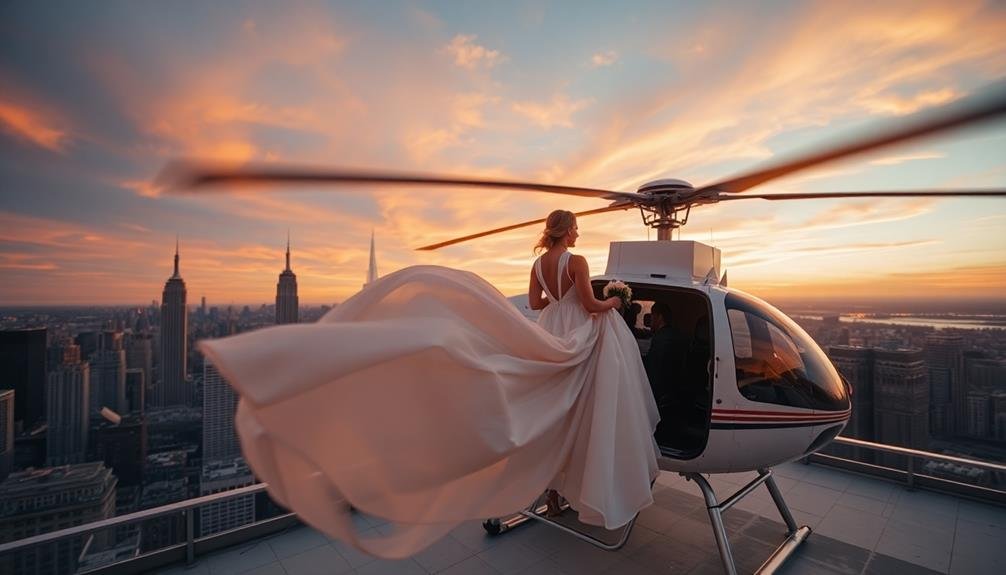
Soar into wedding photography excellence with a perfectly planned aerial exit. You'll need to take into account several factors to capture breathtaking shots from above.
First, choose the right location. Look for open spaces with minimal obstructions and interesting patterns or textures when viewed from above.
Next, select the appropriate equipment. A drone with a high-quality camera is essential. Make sure you're familiar with its controls and capabilities before the big day. Don't forget spare batteries and memory cards.
Timing is vital. Coordinate with the couple and wedding planner to determine the best moment for the aerial exit. Late afternoon or golden hour often provides the most flattering light.
Think about the composition. Plan shots that showcase the couple, their guests, and the surrounding environment. Experiment with different heights and angles to create dynamic images.
Safety is paramount. Check local regulations and obtain necessary permits. Brief the couple and guests on safety procedures. Have a spotter assist you during the flight.
Essential Drone Equipment
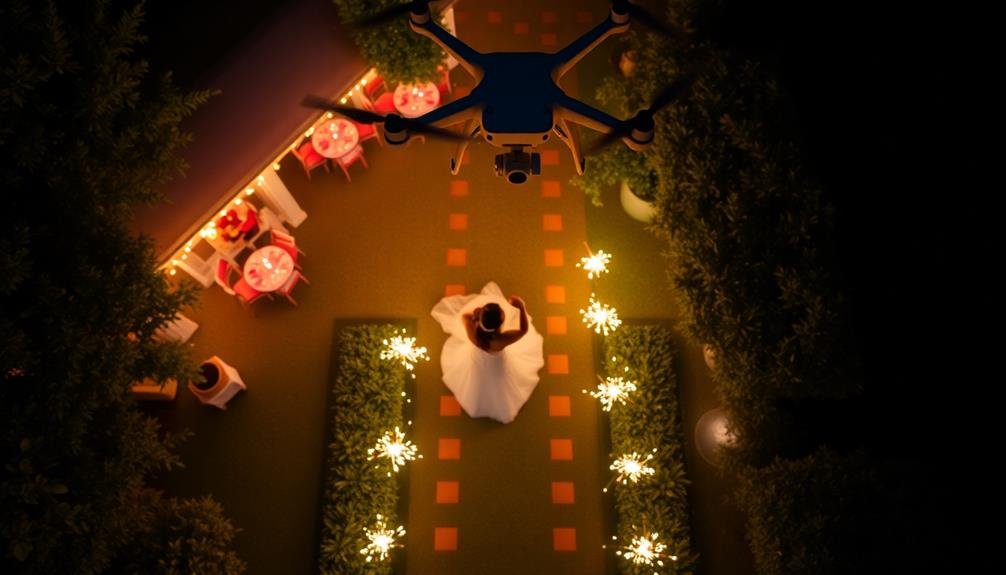
To capture stunning aerial wedding exit shots, you'll need the right drone equipment.
Start by selecting a top-performing drone model suited for event photography, such as the DJI Mavic 3 or Autel EVO Lite+.
Don't forget essential accessories like extra batteries, ND filters, and a sturdy carrying case to guarantee you're fully prepared for the big moment.
Top Drone Models
Drones have revolutionized wedding photography, offering stunning aerial perspectives of exit moments. When choosing a drone for capturing these unforgettable scenes, you'll want to take into account top models that combine image quality, flight stability, and ease of use.
The DJI Mavic 3 Pro stands out with its Hasselblad camera, delivering exceptional 4K video and 20MP stills. It's compact, foldable, and boasts an impressive 46-minute flight time.
For a more budget-friendly option, the DJI Mini 3 Pro offers 4K video and 48MP photos in a lightweight package that doesn't require FAA registration.
If you're after cinematic footage, the Autel EVO Lite+ features a 1-inch CMOS sensor and can shoot 6K video. Its 40-minute flight time guarantees you won't miss vital moments.
For professionals, the DJI Inspire 2 offers interchangeable lenses and dual-operator control, ideal for complex shots.
Remember to factor in portability, battery life, and obstacle avoidance features when making your choice. Each of these top models provides unique advantages for capturing breathtaking wedding exit moments from above.
Essential Drone Accessories
Equipping your drone with essential accessories can greatly enhance your wedding exit photography. These add-ons not only improve image quality but also guarantee safer and more efficient flights.
When capturing those magical moments as newlyweds depart, you'll want to have the right gear to get the perfect shot.
Consider investing in these vital drone accessories:
- High-quality ND filters: These reduce light entering the camera, allowing for slower shutter speeds and smoother footage, especially in bright conditions.
- Extra batteries and a multi-charger: Wedding exits often happen late, so you'll need plenty of power to capture the entire event without interruption.
- Propeller guards: These protect your drone and guests from potential accidents, providing an extra layer of safety during close-up shots.
- Landing pad: A portable landing surface keeps your drone clean and stable, particularly useful when taking off from uneven or dirty surfaces.
Don't forget to pack a rugged carrying case to protect your drone and accessories during transport.
With the right equipment, you'll be ready to capture stunning aerial shots of the newlyweds' grand exit, creating unforgettable memories for the happy couple.
Scouting the Wedding Venue
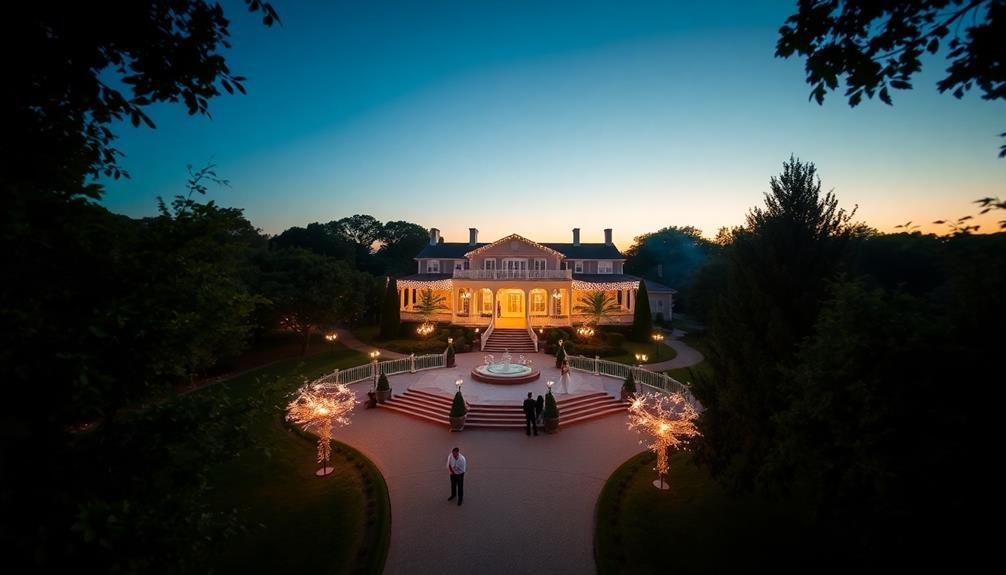
When scouting the wedding venue, you'll need to focus on three key aspects.
First, assess the venue layout and identify ideal angles for capturing the exit moment.
Next, evaluate the lighting conditions at the expected exit time to determine if additional equipment is necessary.
Venue Layout and Angles
To capture stunning wedding exit moments, scouting the venue layout and identifying ideal angles are essential steps. As you explore the location, pay attention to the exit path and surrounding features. Look for architectural elements, natural backdrops, or unique lighting that can enhance your shots.
Consider the time of day when the exit will occur and how it'll affect the ambient light.
During your venue walkthrough, keep these key points in mind:
- Identify multiple vantage points for diverse shots
- Look for elevated positions to capture a bird's-eye view
- Note potential obstacles that might block your view
- Consider the direction of light and how it'll impact your shots
Don't forget to check for any venue restrictions on where you can position yourself or your equipment.
If possible, visit the venue at the same time of day as the planned exit to get a better sense of the lighting conditions. This preparation will help you anticipate challenges and opportunities, ensuring you're ready to capture those fleeting, magical moments as the newlyweds make their grand exit.
With a solid understanding of the venue layout and prime angles, you'll be well-equipped to create unforgettable wedding exit photographs.
Lighting Conditions Assessment
Evaluating lighting conditions is essential when scouting a wedding venue for exit photos. You'll need to assess both natural and artificial light sources to determine the best camera settings and equipment for capturing stunning exit moments. Consider the time of day when the exit will occur, as this dramatically affects available light.
During your venue visit, take note of:
| Light Source | Characteristics | Considerations |
|---|---|---|
| Natural Light | Soft, warm at sunset | Golden hour timing |
| Streetlights | Harsh, yellow cast | White balance adjustment |
| Venue Lighting | Varies, often dim | Additional lighting needed |
| Exit Props | Sparklers, lanterns | Safety and exposure settings |
Pay attention to potential shadows or dark spots along the exit path. You might need to bring additional lighting equipment to fill these areas. Don't forget to check for reflective surfaces that could cause unwanted glare or create interesting effects in your shots.
If possible, visit the venue at the same time of day as the planned exit. This will give you the most accurate representation of lighting conditions you'll face. Remember, you can't control the weather, so have a backup plan for unexpected changes in natural light.
Exit Pathway Planning
Once you've assessed the lighting conditions, your next step is to plan the exit pathway. This vital stage involves scouting the wedding venue to identify the best route for the couple's grand departure.
You'll want to find a path that's not only visually appealing but also practical for both the newlyweds and your photography setup.
Start by walking the potential exit routes yourself, noting any obstacles or unique features. Consider the following factors when planning the pathway:
- Length of the route: Confirm it's long enough for multiple photo opportunities but not so long that it becomes tedious for the couple.
- Background elements: Look for interesting architectural features or natural scenery that can enhance your shots.
- Guest positioning: Determine where guests can line up to create a visually striking sendoff.
- Safety concerns: Check for uneven surfaces, steps, or other potential hazards that could affect the couple's exit or your ability to capture it.
Choreographing the Exit Scene

For a memorable wedding exit scene, careful choreography is key. You'll want to coordinate with the couple and their wedding planner to create a smooth, visually appealing exit.
Start by positioning guests strategically along the exit path, guaranteeing they're evenly spaced and have easy access to their exit props. Instruct guests on the proper timing and technique for using their props, whether it's tossing confetti, waving sparklers, or blowing bubbles.
You might consider doing a quick rehearsal to guarantee everyone understands their role. Position the couple at the start of the exit path and give them clear cues for when to begin their walk.
As the photographer, you'll need to choreograph your own movements too. Plan your shooting positions in advance, considering the lighting and backdrop at each point.
You might start at the beginning of the path for close-ups, then move to capture wider shots as the couple progresses. Don't forget to communicate your plans with videographers or second shooters to avoid getting in each other's way.
With careful planning, you'll capture a beautifully orchestrated exit scene.
Lighting Considerations for Night Shots

The glow of sparklers and the soft illumination of string lights create a magical ambiance for wedding exit photos, but they also present unique lighting challenges.
To capture these moments effectively, you'll need to master low-light photography techniques and utilize the available light sources creatively.
First, adjust your camera settings to accommodate the dim conditions. Increase your ISO, open up your aperture, and slow down your shutter speed. However, be cautious not to blur the action. A tripod can help stabilize your camera for longer exposures.
Consider using off-camera flash to add depth and dimension to your shots. Place flashes strategically to highlight the couple and create a beautiful backlight effect. Don't forget to balance the artificial light with the ambient glow for a natural look.
Here are four essential lighting tips for night exit shots:
- Use a high-quality lens with a wide aperture
- Experiment with different light sources (sparklers, lanterns, fairy lights)
- Incorporate venue lighting into your composition
- Practice beforehand to perfect your technique
Capturing Movement and Energy
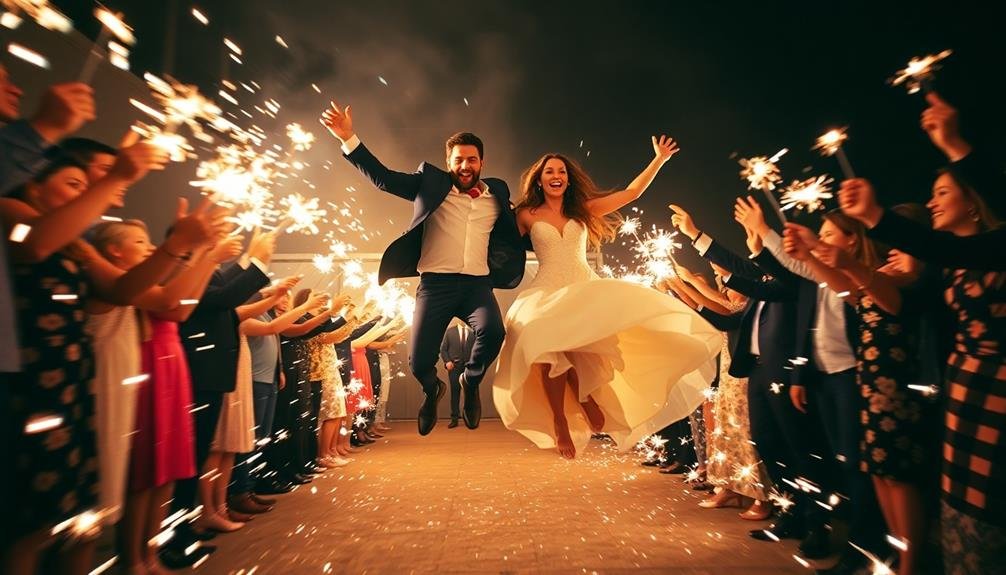
To capture the movement and energy of wedding exit moments, you'll need to master shutter speed techniques.
Focus on using faster shutter speeds to freeze action or slower speeds for creative blur effects.
Employ dynamic composition strategies, such as leaving space for subjects to move into the frame, and be ready to anticipate peak action moments like confetti throws or sparkler waves.
Shutter Speed Techniques
Mastering shutter speed techniques is essential for capturing the energy and movement of wedding exit moments. You'll need to balance freezing the action with conveying motion, depending on the desired effect.
For sparkler exits, try using a slower shutter speed (around 1/15 to 1/30 second) to capture light trails while maintaining some sharpness in the couple's faces.
For confetti or bubble exits, experiment with faster shutter speeds (1/250 to 1/500 second) to freeze individual particles in mid-air. If you want to showcase movement, opt for a slightly slower speed (1/60 to 1/125 second) to introduce some motion blur.
To nail your shutter speed techniques, follow these tips:
- Use shutter priority mode for quick adjustments
- Anticipate the action and pre-focus on the couple
- Increase your ISO in low-light situations to maintain faster speeds
- Practice panning to capture sharp subjects with blurred backgrounds
Don't forget to take into account your aperture when adjusting shutter speed. A wider aperture (lower f-number) allows more light, enabling faster shutter speeds in challenging lighting conditions.
Dynamic Composition Strategies
With dynamic composition strategies, you'll elevate your wedding exit photos from good to extraordinary. Start by using the rule of thirds to position the couple off-center, creating a more visually interesting image. Incorporate leading lines, such as rows of guests or sparklers, to draw the viewer's eye towards the newlyweds.
Experiment with different angles to capture the energy of the moment. Get low to the ground for a dramatic upward shot, or find a higher vantage point to showcase the entire scene. Use framing techniques, like shooting through an archway or between guests, to add depth and context to your images.
Don't forget about negative space – it can emphasize the couple and create a sense of movement. Capture motion blur by panning with the couple as they walk or run, keeping them in focus while blurring the background.
For a unique perspective, try a wide-angle lens to exaggerate the sense of space and include more of the surrounding environment.
Lastly, anticipate peak moments of action, such as when confetti is thrown or sparklers are lit, to capture the height of excitement and energy in your compositions.
Anticipating Peak Action
Anticipating peak action is the cornerstone of capturing unforgettable wedding exit moments. As a photographer, you'll need to be one step ahead, ready to freeze those split-second bursts of joy and excitement. Keep your finger on the shutter and your eyes peeled for telltale signs of impending action.
To successfully anticipate peak moments, follow these key strategies:
- Study the exit plan: Familiarize yourself with the couple's chosen exit method, whether it's a sparkler sendoff, confetti toss, or bubble parade.
- Position yourself strategically: Find the ideal spot that allows you to capture both the couple and guests' reactions.
- Watch for cues: Pay attention to the crowd's energy and the couple's body language for hints of upcoming action.
- Use burst mode: Set your camera to continuous shooting to increase your chances of catching the perfect frame.
Framing Techniques for Aerial Shots
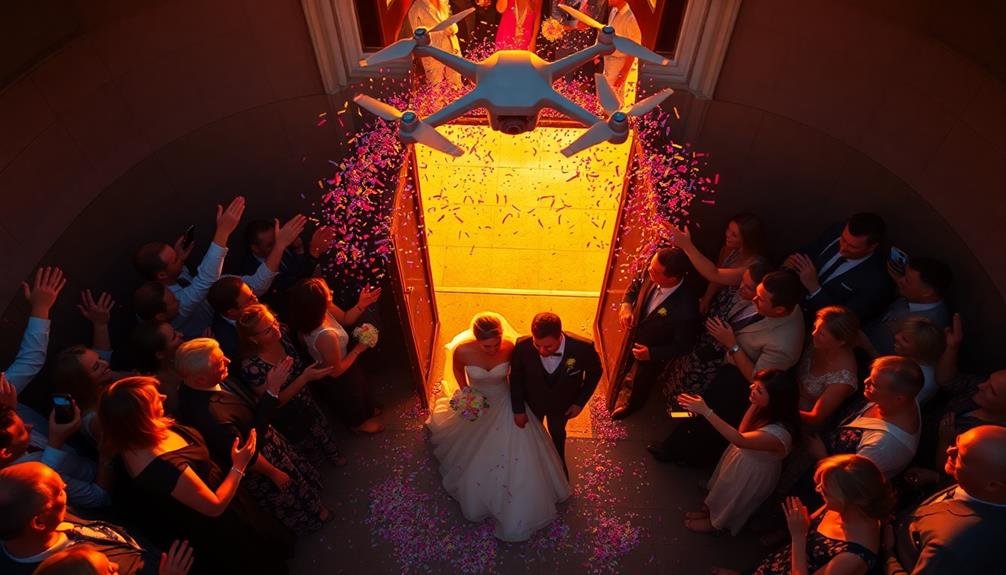
Capturing aerial shots of wedding exits requires careful framing to create stunning, memorable images. When you're shooting from above, consider using the rule of thirds to position the couple or the exiting crowd. Place them along the gridlines or at intersecting points for a visually appealing composition.
Don't forget to leave negative space, which can add drama and context to your shots. For a unique perspective, try framing the exit through natural elements like tree branches or architectural features of the venue. This adds depth and interest to your aerial photos.
If you're using a drone, experiment with different heights and angles to find the most flattering view of the scene below. Pay attention to symmetry and patterns in the landscape or crowd formation. These can create visually striking images when viewed from above.
You can also use leading lines, such as pathways or decorative elements, to draw the viewer's eye towards the main subjects. Remember to adjust your camera settings for the lighting conditions, as aerial shots often involve challenging light situations.
Coordinating With Ground Photographers
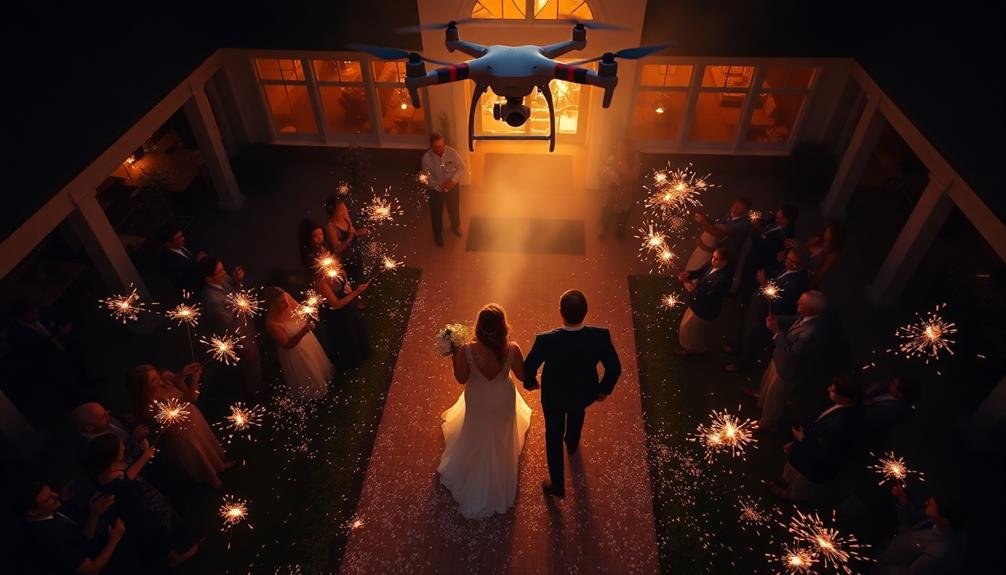
Successful wedding exit photography often involves a team effort. As an aerial photographer, you'll need to coordinate closely with ground-based photographers to guarantee extensive coverage of the exit moment. Establish clear communication channels and develop a shared plan before the event. This collaboration will help you avoid interfering with each other's shots while maximizing creative opportunities.
To effectively coordinate with ground photographers:
- Discuss timing and positioning in advance, making sure you're both aware of each other's planned movements and angles.
- Use hand signals or radio communication during the exit to alert each other of potential shot opportunities or obstacles.
- Share your equipment details and capabilities, allowing for complementary coverage that plays to each photographer's strengths.
- Plan for contingencies, such as unexpected weather changes or last-minute alterations to the exit plan.
During the exit, maintain awareness of your drone's position relative to ground photographers. Adjust your altitude and angle as needed to avoid casting shadows or appearing in their shots.
Weather Challenges and Solutions

Numerous weather challenges can impact aerial wedding exit photography, but with the right preparation and quick thinking, you can overcome them.
Strong winds pose a significant risk to drone stability, affecting image quality and safety. Combat this by using a drone with advanced stabilization features and adjusting your flight patterns to minimize wind resistance.
Rain and moisture can damage your equipment and obscure visibility. Always check the weather forecast and have a waterproof drone or protective gear on hand. If light rain is unavoidable, use lens filters to reduce water droplets on your camera.
Low light conditions during evening exits can result in grainy or blurry images. Increase your drone's ISO and lower the shutter speed, but be cautious of motion blur. Consider using a drone with a larger sensor for better low-light performance.
Extreme temperatures can affect battery life and drone performance. In cold weather, keep spare batteries warm and limit flight times. For hot conditions, avoid overheating by providing shade for your drone between flights and minimizing direct sunlight exposure.
Lastly, fog or haze can create atmospheric effects but may reduce visibility. Adjust your camera settings to enhance contrast and use post-processing techniques to bring out details in misty shots.
Post-Processing Aerial Wedding Photos

Post-processing magic can transform your aerial wedding exit photos from good to spectacular. When editing your drone shots, focus on enhancing the overall atmosphere and highlighting the unique perspective.
Start by adjusting exposure and contrast to bring out the details in both bright and shadowy areas. Color correction is essential; aim for a cohesive palette that complements the wedding's theme and the natural surroundings.
To take your aerial wedding exit photos to the next level, consider these techniques:
- Use selective sharpening to emphasize key elements like the couple, guests, or decorations without over-processing the entire image.
- Experiment with cropping to create dynamic compositions that showcase the scale and grandeur of the location.
- Apply subtle vignetting to draw the viewer's eye to the center of the frame, where the main action is typically happening.
- Utilize noise reduction tools to clean up any graininess caused by low-light conditions or high ISO settings.
Don't forget to retouch any distracting elements, such as unexpected objects or bystanders.
Legal Requirements for Drone Photography

When venturing into drone photography for weddings, you must navigate a complex web of legal requirements. First, obtain a Remote Pilot Certificate from the FAA by passing the Part 107 exam. This certification demonstrates your knowledge of airspace regulations, weather patterns, and safe drone operation.
Register your drone with the FAA if it weighs more than 0.55 pounds. You'll need to display the registration number on your aircraft. Always carry your pilot certificate and drone registration when flying.
Before each flight, check local restrictions and obtain necessary permissions. Some areas may require additional clearance or have specific no-fly zones. Be aware of airspace classifications and adhere to altitude limits.
Here's a quick reference guide for essential legal requirements:
| Requirement | Details |
|---|---|
| Certification | FAA Remote Pilot Certificate |
| Registration | Drones over 0.55 lbs |
| Insurance | Liability coverage recommended |
| Waivers | For night flights or over people |
Frequently Asked Questions
How Long Does It Take to Learn Drone Photography for Weddings?
You'll need several months to master drone photography for weddings. Start with basic flight skills, then progress to capturing dynamic shots. Practice regularly, learn composition techniques, and familiarize yourself with wedding-specific scenarios to become proficient.
Can Drones Capture Audio for Wedding Exit Videos?
You'll find that most consumer drones can't capture high-quality audio due to propeller noise. If you're set on audio, you'll need to use separate recording devices or consider specialized drones with enhanced audio capabilities.
What Insurance Is Needed for Aerial Wedding Photography?
You'll need liability insurance to cover potential damages or injuries. It's crucial to have drone-specific coverage, which protects against accidents and equipment failure. Don't forget to check local regulations and obtain necessary permits for aerial photography.
How Do You Handle Unexpected Guests During the Exit Shot?
You'll need to think on your feet. Politely ask unexpected guests to step aside, or quickly incorporate them into the shot if appropriate. Be flexible and maintain a positive attitude to keep the couple's exit moment special.
Are There Specific Drone Models Recommended for Wedding Photography?
For wedding photography, you'll want to contemplate drones like the DJI Mavic 3 Pro or Air 2S. They're compact, easy to use, and offer excellent image quality. Don't forget to check local regulations before flying!
In Summary
You've now got the tools to capture breathtaking aerial wedding exits. Remember, it's all about preparation, coordination, and creativity. Don't forget to check local regulations and obtain necessary permits. With practice, you'll master the art of framing, timing, and editing these unique shots. Keep pushing your skills, and you'll soon be known for delivering unforgettable aerial wedding memories that couples will cherish for a lifetime. Take flight and let your photography soar!

As educators and advocates for responsible drone use, we’re committed to sharing our knowledge and expertise with aspiring aerial photographers.




Leave a Reply